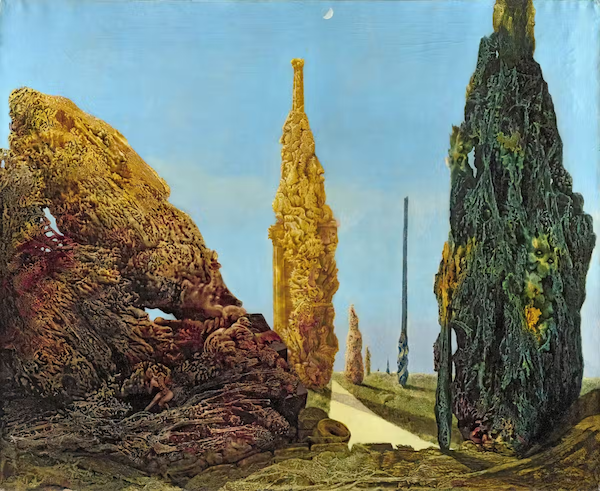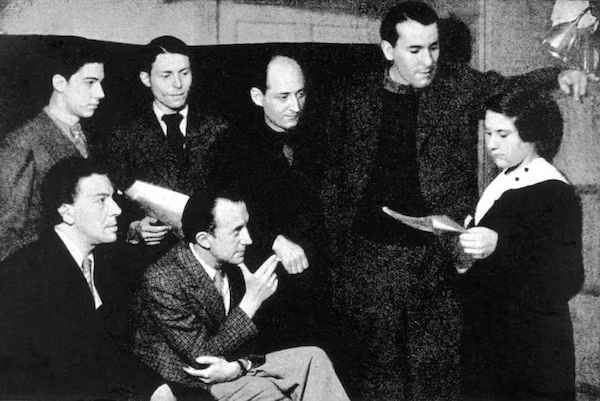Lambert here: Seems appropriate….
By Mark Robert Rank, Professor of Social Welfare, Arts & Sciences at Washington University in St. Louis. Reposted from Alternet.
A century ago, French writer and poet André Breton penned his “Manifesto of Surrealism,” which launched an art movement known for creating bizarre hybrids of words and images.
These juxtapositions, often generated through chance, were thought to stimulate the unconscious mind to cultivate new insights.
Man Ray’s puzzling photographs of out-of-focus collages or Salvador Dalí’s jarring paintings of melting clocks and elongated elephants were typical of the form.
As I detail in my book “The Random Factor,” much of life is influenced by randomness – from natural evolution to the selection of friends and spouses. The surrealists, too, made randomness a cornerstone of their artistic practice.
Manifestations of the Marvelous
In 1928, the artist Otto Umbehr, known simply as Umbo, snapped a picture from his window that randomly captured the street scene below.
The power of the image – “Mystery of the Street” – comes not from its content but from its orientation. When Umbo developed the photograph, he decided to invert it. The result is an ordinary image of people but with their elongated shadows taking on a startling life of their own.
As contemporary photographer Sandrine Hermand-Grisel writes, “The surrealists question the documentary value of photography. They perceive its capacity to capture the manifestations of the marvelous that can happen at random.”
Surrealist painter Max Ernst often employed the technique of “decalcomania,” which involved applying a layer of paint to a surface, such as glass, and then transferring the wet paint directly onto the canvas. Some of the paint would stick – some of it wouldn’t. No matter: Ernst would build off the random patterns and textures to create the painting.

Max Ernst’s 1940 painting ‘Solitary and Conjugal Trees’ used the technique of decalcomania. Museo Nacional Thyssen-Bornemisza
Out of Many, One
Another surrealist practice involving randomness came to be known as the “exquisite corpse.”
The earliest version of the collaborative exercise involved gathering a small group of friends and dividing a sentence into various parts of speech, such as nouns, verbs, adjectives, adverbs and so on. Each part of the sentence would be assigned to one person. The first person would write down a word for their part of the sentence, fold the paper over and hand it to the next person. The second person would then select their word, not knowing what the first person had written down, and pass the developing sentence onto the next person.
In this way, the sentence would be written as it traveled around the room without anyone knowing what the sentence looked like until it was completed and someone unfolded the paper.
The process results in sentences that people wouldn’t concoct on their own. According to legend, the first sentence constructed by André Breton and his fellow surrealists read, “The exquisite corpse shall drink the new wine.”

A photograph by Man Ray of a group of surrealists conversing. André Breton is seated on the far left. Photo12/UIG via Getty Images
Random by Design
The principle of the exquisite corpse has been applied to other creative ventures.
The Blackwing 602, manufactured by the Eberhard Faber Pencil Company, is one of the most iconic pencils of the 20th century. Pitched with the tagline “Half the Pressure, Twice the Speed,” it became known for the quality of its graphite and its unique, rectangular eraser.
The Blackwing was a favorite of many writers and artists, including John Steinbeck, Leonard Bernstein and animator Chuck Jones of “Looney Tunes” fame. But Eberhard discontinued the Blackwing pencil in the 1990s.
Fast-forward to 2010. The California Cedar Products Company reintroduced the Blackwing 602. In March 2018, the company designed a limited edition Blackwing pencil to commemorate the surrealists by using the exercise of the exquisite corpse to fashion a new pencil.
They divided the parts of the pencil into five sections: graphite, barrel, imprint, ferule and eraser. The first person of the design team selected the graphite. The second person, who was unaware of the first person’s choice, designed the barrel, and so on.
The result was a stunning pencil – one of my favorites – that would have never existed were it not for a willingness to surrender to randomization.
The pencil has a rose-colored barrel with teal imprint, a silver ferule, a blue eraser and extra-firm graphite. The company dubbed it the Blackwing Volume 54 in honor of 54 Rue du Chateau in Paris, the address for the house where that very first exquisite corpse exercise took place.
A Leap of Faith
Musicians, filmmakers and graphic designers also incorporate randomness into their work. The composer John Cage often used randomness and chance in his compositions. In one piece, a pianist sits silently for 4 minutes and 33 seconds, compelling the audience to experience the random coughs and rustling in the room.
In his “Imaginary Landscape” series, random elements produced by electricity are part of the performance; for instance, during one performance, Cage placed 12 radios on the stage, each tuned to a different station, and played them simultaneously. In describing this process, Cage wrote, “Chance, to be precise, is a leap, provides a leap out of reach of one’s own grasp of oneself.”
As museums around the world celebrate the centennial of the birth of surrealism, it’s important to recognize that embracing randomness allowed these artists to think outside the box. The use of chance as a tool of creativity continues to this day, providing a helping – and surprising – hand, taking artist and audience to places heretofore unknown.


Perhaps apropos, AI LLM models use randomness to select output tokens from among a selection of most likely candidates. Without this the output would be deterministic from the prompt, and would not appear anywhere near as “intelligent”.
Thank you for setting that up.
There is no other intelligence more artificial than my own.
Feels good to get that off my chest.
Reminds me of a classic joke:
When most of us got our music from the radio, that was somewhat random (random but repetitive). I bought a good TEAC dual cassette deck so I could make mixtapes, then did likewise with CD burning. Not random enough.
I now collect my music into folders and when I want to listen to that kind of music, I just dump the folder into VLC set on random play. I never know what will be next but it’s ususally music I’ve sampled but never really listened to before. Random and fresh go together well.
I looked at way too many surrealistic paintings growing up, have memories of Ernie Kovacs’ B&W comedy show and have always been a sucker for bizarre cartoons. Jefferson Airplane’s Surrealistic Pillow was one of my favorite ’60s albums.
Surrealism makes functional creativity easy. No one ever hired Dali to do cereal boxes but box art trends Dali-esque nonetheless. Then a Roy Lichenstein or Andy Warhol turns the box art into pop art paintings which in turn are transformed, incorporated into or cannibalized for still more new art.
Or at least that was true before weaponized copyright law was created to kill digital replicators.
No one ever hired Dali to do cereal boxes . . .
But he did do magazine covers and plenty of commercials. Not that there’s anything wrong with that!
He also designed the Chupa Chups logo.
I always use the “shuffle” feature on my music player as I love being surprised. I have a fair amount of music that I haven’t heard before, and if I don’t care for a song I skip it.
During my brief dabble with college, I took a couple of classes from a disciple of Cage. Took part in performing a few of his pieces. Intellectually interesting, but honestly not very edifying spiritually. Not like, say, listening to Aretha. However, I do find the paintings of the surrealists to be every bit as fulfilling as any other genre.
One point my professor did make that stuck: He insisted that if you’re going to listen to music, then LISTEN. And if you’re not, don’t. He insisted that wearing headphones anywhere out of the house was dumb, because of how much you end up missing. Forty odd years later and I don’t regret following that advice at all. The world’s sounds, be they meadowlarks or garbage trucks, are constantly combining in new and surprising ways. I’m glad I learned to pay attention.
I also took a course with Cage, one of the highlights of my student career. I have performed 4’33” a few times to mostly skeptical groups of music majors. Such a performance is more difficult than one might imagine in our society, where music is, more often than not, treated as sonic wallpaper.
Cage used the term “aleatoric”, not “random”. This is a kind of guided randomness, for example, in “Music of Changes”, where he utilized the I Ching (in a manner that greatly upsets a classical Chinese scholar friend of mine to this day).
I got a “like” from Moor Mother once for tweeting that with some of her music, I liked to open the windows and adjust the sound so that I wasn’t always sure which sounds were hers, and which were coming in from outside.
This was true for some but definitely not most of her music, btw.
With Cage, I’ve always suspected that the fun is all on the audience’s side. With much avant garde music, surprise is a key ingredient and I would imagine it’s hard to be surprised by a piece you’ve been practicing in rehearsal all week.
“Procedural generation”, very common in games. Uses random noise to Create the illusion of a unique world with no work from a human (apart from designing the engine). These are always shallow and repetitive, but sometimes big enough to fool for a while.
Randomness does not a lived-in world make. It is at best a spice. Nature is rife with purpose.
The work of Dalí has aged particularly poorly. It’s just way too on the nose. The surrealists were half bent on fascism and mostly sustained by the patronage of poor little rich girls with nothing much to do but prance and pose. Magritte was outside the circle but also a particularly nasty personality. Though his paintings have some bite, toujours.
I don’t judge their works by who they were. Especially since I’m very fond of the Futurists and Heidegger, I’d burn in hell otherwise.
If one is a fan of surrealism, I’d argue we are living in the golden age of neo-surrealism.
Everything from social media to politics is straight from a paleo-surrealist’s playbook. Just spend 5 min on Tiktok, lol!
Randomness mirrors the incoherence of much of our thought process, which is after all spurred by the firing of neurons in a sometimes random manner. And that bleeds over into our normal (not formal) speech a fair amount, one reason why few fictional works recount conversations the way they actually occur, but instead make them far more orderly and with fewer hesitations, false starts, and non sequiturs.
It ain’t 4:33 of silence, but it is 2:53 of some sur/real noise recorded in situ.